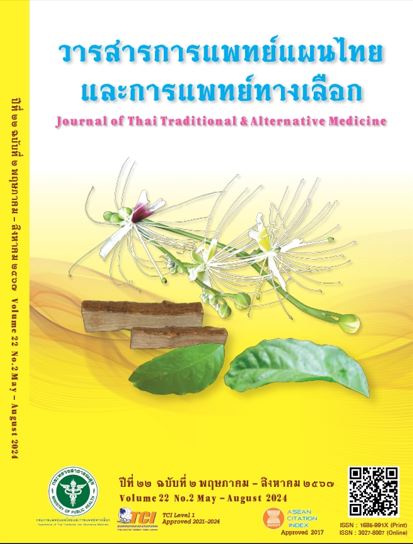Study on the Treatment of Low Back Pain Using Cupping Therapy in Traditional Chinese Medicine
Main Article Content
Abstract
Introduction and Objective: Low back pain (LBP) is a common health issue that significantly affects patients’ quality of life. Traditional Chinese medicine (TCM) offers interesting treatment modalities, particularly Cupping Therapy, whichhasgainedincreasingattentionfor the managementof LBP. This studyaimedtoreview andsynthesize researchevidenceontheuseof Cupping Therapyfor the treatmentof LBPinthe contextof TCM.
Methodology: This literature review involved the search in major electronic databases, including Thai Journal Online (ThaiJO), China National Knowledge Infrastructure (CNKI),PubMed, and Web ofScience, from January2014toDecember2023. Thekeysearchtermsincluded“traditional Chinesemedicine,”“Cupping Therapy,” “low back pain,” and “lumbarpain.”
Results: Cupping Therapyhasbeenfoundtosignificantlyreducetheintensityof lowerbackpain, improve the mobility of back muscles, and enhance the quality of life of patients. Furthermore, the therapy has a high safety profile and can be used in combination with other treatments, such as modern medications, Chinese herbal medicines, acupuncture, therapeutic bleeding, heat compress, or exercise, to enhance the overall effectiveness of the treatment.
Discussion: Cupping Therapy is an effective treatment modality for the management of lower back pain, which aligns with the TCM principle of restoring the body’s balance. When combined with other treatment approaches, the therapy can further improve the treatment outcomes. However, there are limitations in this study suchasvariations in Cupping Therapytechniques,heterogeneityof LBPsymptoms, anddifferences infollow-up durations, which warrant further investigation.
Conclusion and Recommendation: Cupping Therapyhasbeenfoundtobeaneffectivetreatment for lower back pain according to the TCM principles, and can be used in conjunction with other therapies to enhance the overall treatment efficacy.Specifically, the therapyhasbeenshowntosignificantlyreducepainintensity, improve spinal mobility,andenhancethequalityof lifeofpatients,andpossessahighsafetyprofile. Therefore, thetherapy maybeapromisingtreatmentoptionfor lower back pain. However, more in-depth studies are needed in the future to provide a deeper understanding of this therapeutic approach.
Article Details

This work is licensed under a Creative Commons Attribution-NonCommercial-NoDerivatives 4.0 International License.
References
Vanarat L, Hasanine T, Techadamrongsin Y. Basic traditional chinese medicine. Bangkok: The War Veterans Organization of Thailand Under Royal Patronage of His majesty the King; 2008. (In Thai)
Announcement of the Ministry of Public Health. Thailand B.E. 2552 (2009), Royal Gazette, Vol. 126, Special Part 26G. (2009 Feb 16). (In Thai)
Khamphiraphap K. Diagnostics of traditional Chinese Medicine. Bangkok: Religious Printing House; 2006. (In Thai)
Srijaroen W, Sribenchamas N. Factors related to back pain among personnel at Pibulsongkramrajabhat University. Rajabhat J. Sci. Humanit. Soc. Sci.2016;17(2): 252-60 (In Thai)
Udompriboonwong R. Cupping Therapy [Internet]. Huachiew TCM Clinic. 2022 Aug [cited 2023 Jun 5]. Available from: https://www.huachiewtcm.com/content/6152/ cupping-therapy (In Thai)
Wannawibool B, Danaiswat P, Kiartivich S, Noomhorm N, Wannawibool N, Chiaopromkun T, et al. Comparison of the Effectiveness of Manually Stimulated and Electrically Stimulated Scalp Acupuncture in Patients with Lower Back Pain: A Randomized Controlled Trial. Journal of Thai Traditional and Alternative Medicine. 2020;18(3):523-34
Downie, W. W., Leatham, P. A., Rhind, V. M.,Wright, V., Branco, J. A., & Anderson, J. A.(). Studies with pain rating scales. Annalsof the Rheumatic Diseases Journal, 1978; 37: 378-81
Sanjaroensuttikul N. The Oswestry low back pain disability questionnaire (version 1.0) Thai version. J Med Assoc Thai. 2007; 90: 1417-22 (In Thai)
Liang F, Wang H. Acupuncture and moxibustion. Beijing: China Traditional Chinese
Medicine Press; 2016. 329. (In Chinese)
National Statistical Office Ministry of Digital Economy and Society. The 2017 food consumption behavior survey. Bangkok: National Statistical Office; 2018. 103 (In Thai)
Meng X, The Literature Study Of Cupping therapy on Advantage Diseases (thesis). Shandong: Shandong University of Traditional Chinese Medicine; 2011. (In Chinese)
Shu M, Guan L. Curative effects of moving cupping therapy on chronic back pain and related changes in IL-2 and IL-8. Academic Journal of Chinese PLA Medical School [Internet]. 2019 [cited 2023 Jun 7]. Available from: https://caod.oriprobe.com /articles /57993668/ Curative_effects_of_moving_cupping_therapy_on_chro.htm
Xu P, Cui Sh, Wee DA, Xu Sh, Leang L. Preliminary observation on effect of cupping on the skin surface temperature of patients with back pain. World Journal of Acupuncture - Moxibustion 2014;24(4):59-61. (In Chinese)
Zhou W, Shi X, Shi D, Bao X, Jiang F. Clinical Application Overview of Moving Cupping in the Treatment of Low Back Pain. Jilin Journal of Chinese Medicine. 2019: 8(39);1094-96. (In Chinese)
Pan L, Ma X, Han S, Hu H. Comparative Study on the Thereapeutic Efficacy between Medicinal Cupping and Bloodletting for Chronic Low Back Pain. Shanghai Journal of Acupuncture and Moxibustion. 2016;9(35):1112-14. (In Chinese)
Zhang QE, Lai Zh. Comparative study on cupping therapy and hot compress therapy on low back pain in patients with orthopedic bedridden. China Journal of Modern Medicine. 2017:26;130-33. (In Chinese)
Zhang f. 33 cases of chronic nonspecific low back pain of Qi stagnation and
blood stasis type treated by cupping and bloodletting at Ashi point combined with
Baduanjin. Fujian Journal of Traditional Chinese Medicine. 2022;53(4):12-14 (In Chinese)
Chansirinukor W, Maher CG, Latimer J, Hush J. Comparison of the functional rating index and the 18-item Roland-Morris Disability Questionnaire: responsiveness and reliability. Spine (Phila Pa 1976). 2005 Jan 1;30(1):141-5. doi: 10.1097/00007632-200501010-00023. PMID: 15626994.
Huang G. Clinical study on acupuncture combined with pain point pricking and cupping for non-specific low back pain (dissertation). Liaoning:Liaoning University of Traditional Chinese Medicine;2018. (In Chinese)


